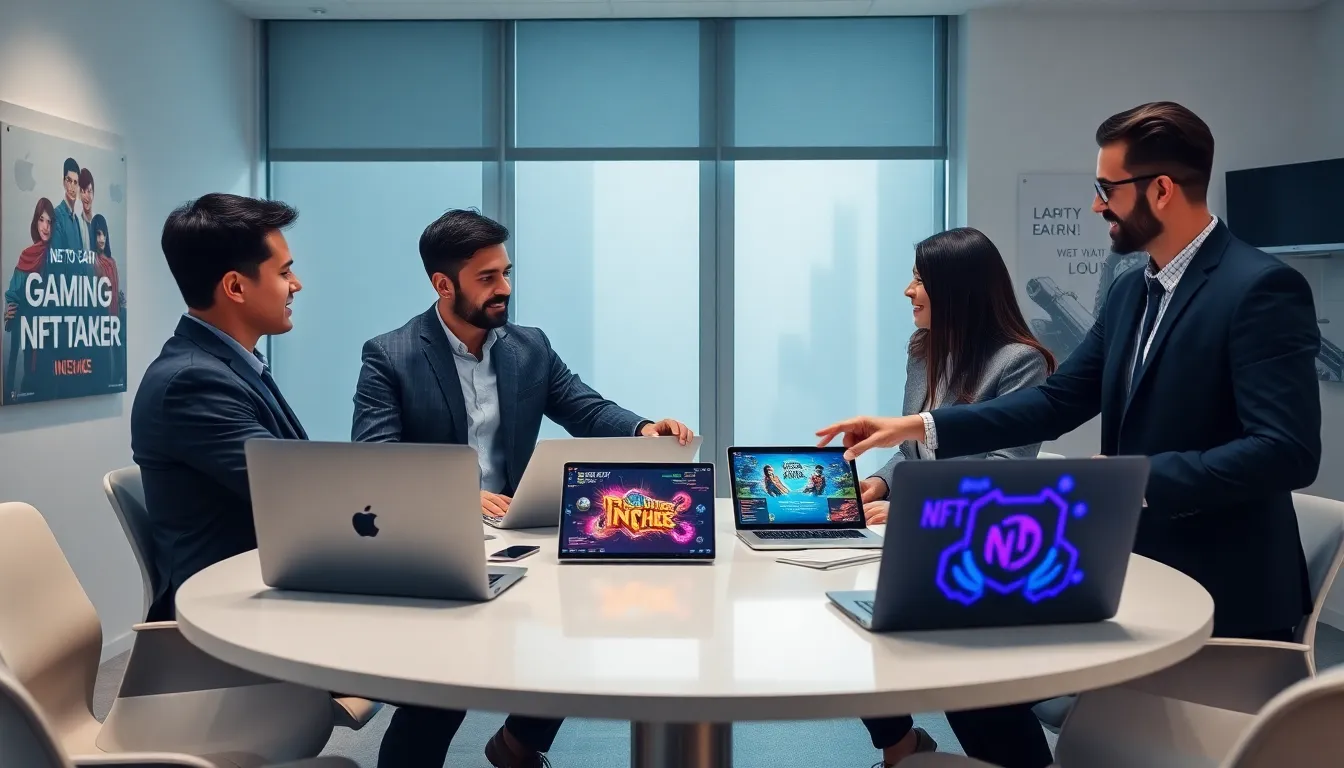In a world where players are transforming their gaming sk.ll into real cash, the phrase ‘play to earn’ is making waves, and not just from virtual sword swings. The excitement around NFT games is buzzing like a beehive on caffeine. If you’ve been dreaming of cashing in while adventuring through pixelated realms, you’ve landed in the right place. Let’s jump into the quirky yet lucrative universe of play-to-earn (P2E) NFT game development and discover the crucial elements you need to turn your grand ideas into reality.
Table of Contents
ToggleUnderstanding Play To Earn Games

Play-to-earn games have revolutionized the way we think about gaming. No longer is gaming just a way to unwind: it’s now a legitimate revenue stream. Players engage in activities that reward them with NFTs, cryptocurrencies, or other digital assets that hold tangible value. The allure of earning while enjoying a game is what sets P2E apart from traditional gaming models. Players complete quests, farm resources, or even engage in battles, all while raking in rewards. Quite the win-win scenario, right? Imagine slaying dragons and, at the same time, watching your crypto wallet swell.
Understanding the mechanics behind these games is crucial for both developers and players. While many P2E games adopt playership mechanics resembling classic gaming, the twist lies in their integration with blockchain technology. Users can trade, sell, and display their earned assets on various platforms, giving material worth to their gaming efforts.
Essentially, P2E is about democratizing value creation in gaming. Anyone, anywhere can tap into this digital milieu and find success. Whether it’s an indie developer or a gaming giant, opportunities abound for those willing to engage with this growing trend.
The Rise of NFT Games
In recent years, NFTs (Non-Fungible Tokens) have exploded onto the scene, capturing the imagination of both gamers and artists alike. What started as a niche concept has transformed into a dominant force in online communities, thanks to the rise of NFT games. These games leverage the uniqueness and ownership capabilities of NFTs, allowing players to possess truly one-of-a-kind items.
The rise can be attributed to several factors. Firstly, gamers today seek more than just entertainment: they want ownership. Traditional games often lock players out of the true value of their in-game acquisitions. Enter NFTs, which provide a solution by attaching permanent ownership rights to digital assets. As a result, players can trade or sell these assets freely in the market.
Secondly, the COVID-19 pandemic led to a surge in digital experiences. Everyone turned to online platforms for engagement and entertainment. This transfer brought NFT gaming into the limelight, making it a trendy and often lucrative venture. We saw a spike in active users in various P2E formats, which only fueled the demand for game development companies specializing in NFT game creation.
Key Features of Play To Earn NFT Games
The world of play-to-earn NFT games brims with enticing features designed to captivate players and ensure continuous engagement.
1. Real Ownership: Unlike traditional games where in-game purchases feel like renting, NFTs grant users real ownership of assets. This establishes a personal connection, making each item cherished.
2. Tradeability: Players can buy, sell, or trade their assets on various marketplaces, turning in-game items into real capital. Imagine completing a quest and then selling your sword for a nice sum.
3. Player Governance: Many NFT games empower their communities by allowing players to vote on game changes or developments. This creates a sense of belonging and enhances player investment in the game’s future.
4. Earning Opportunities Beyond Gameplay: Numerous games introduce non-gaming revenue models, such as staking or providing liquidity. Players can earn rewards just by holding assets.
5. Continuous Development: The best P2E games constantly evolve, introducing new features, quests, and assets to keep the gameplay exhilarating.
Choosing the Right Game Development Company
Selecting the right game development company is pivotal for the success of your play-to-earn NFT game. Here are some factors to consider when making your choice:
Development Process for NFT Games
The development process should be transparent and detailed. Look for a company that offers a structured roadmap covering everything from concept ideation to post-launch support. Effective development requires agile methodologies to adapt to ever-shifting market dynamics.
Essential Technology Stack
A proficient development firm should use a robust tech stack that includes blockchain frameworks like Ethereum or Binance Smart Chain, various programming languages, and game engines. Knowledge of smart contracts is essential to create secure NFT transactions and ensure seamless gameplay.
Monetization Strategies
Evaluate monetization models, are they going for in-game purchases, ads, or token sales? A solid strategy can significantly affect your game’s financial viability. The best companies often provide multiple options to maximize earnings while balancing player enjoyment.
Choosing wisely can initiate your journey into the lucrative world of P2E gaming. Research and due diligence can save you headaches down the road.
Case Studies of Successful NFT Games
Several P2E NFT games have showcased their potential to disrupt the gaming industry.
Axie Infinity: One of the pioneers in the space, Axie Infinity allows players to collect and breed digital pets called Axies, which can fight and earn tokens. With its innovative model, players can earn substantial income, leading to a thriving community.
Decentraland: This virtual world enables users to buy land, create experiences, and monetize them. Users can sell or lease their earned virtual plots, turning passive browsing into a profitable try.
The Sandbox: This game allows players to create, own, and monetize their gaming experiences using NFTs. Thanks to collaborations with famous brands and creators, it’s also making waves for its participatory economy model.
These case studies illustrate how innovative mechanics and strategic thinking can lead to not only entertaining games but also meaningful economic opportunities. The success of these platforms continues to inspire new developers entering the space.
Future Trends in Play To Earn NFT Gaming
The future of play-to-earn NFT gaming looks promising, with several trends emerging.
1. Increased Interoperability: Future games may allow assets to interact across multiple platforms. Players could use their NFTs in various games, leading to a richer gaming experience.
2. Enhanced User Experiences: Developing technologies, such as augmented and virtual reality, will likely be integrated into P2E environments, creating more immersive gameplay.
3. Evolving Economic Models: As the landscape shifts, game developers will need to adapt monetization strategies to ensure sustainability and player retention. Innovations in tokenomics will be essential for balancing player earnings and developer profits.
4. Mainstream Adoption: As awareness spreads, traditional gamers will also enter P2E gaming, offering even more significant opportunities for developers. Collaborations with established gaming platforms could enhance reach and usability.
The convergence of these trends poses exciting opportunities for both gamers and developers. Those who stay ahead of the curve will reap the benefits.


